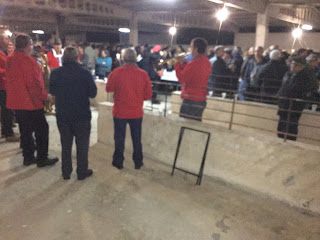So popular in fact that they feature as the centrepiece of a yearly celebration called Magosto, not that Galicians need too much of an excuse for a party. Known as Castañada* in other parts of Spain, it's not limited to Galicia, being celebrated in several other regions and in Portugal, but evidently takes similar form pretty much everywhere.
We were away for this year's celebration, so the images (which are crap, sorry!) in this entry are from last year, which I did attend. The village's newest bar put on a Magosto of their own this year, which I also got to, and the format was essentially the same on a smaller scale - Galicians know what they like - and went down very well.
While this year's harvest has been good, last year's was disastrous because of the long drought. You wouldn't have thought so from the walk up to the old cattle market where the event was held, though. Giant trucks, their trailers already groaning under the weight of huge numbers of chestnuts, stood silently in the street while still more were being deposited into waiting containers:
 |
| Lorry-loads of these, hundreds of thousands of them. And this in a terrible year. |
Harvesting these things is laborious. Machines are available, if you can afford one, to get them off the trees in the first place - they look like an ugly love-child of a combined harvester and a giant hoover. But everybody I know who harvests them has the bastard-spiky cases which they come in removed by hand. So this represents a prodigious effort to get the things to the shops, even in a very low-yield year.
Under the corrugated roof of the market, your three Euros buys you access to essentially unlimited supplies of red wine (very young and not the highlight - best drunk in a Calimocho), barbecued sardines, chestnuts (of course), pregnant bread and bica. Now I love bica - it's a very plain-looking sweet sponge, but if it's made well and it's fresh, it's absolutely fantastic. There is considerable debate about which of the bakeries in the village, and which region of Galicia, produces the best bica. It goes beautifully with coffee and is often served after a big celebratory meal. It also soaks up the local fire water, aguardiente, rather nicely.
But pan preñao, pregnant bread, that was a new one on me. You're given what looks like a plain, warm roll, which at first glance I assumed was to go with the sardines. One bite into it, though, and it becomes clear that it's got a bun in the oven itself:
Under the corrugated roof of the market, your three Euros buys you access to essentially unlimited supplies of red wine (very young and not the highlight - best drunk in a Calimocho), barbecued sardines, chestnuts (of course), pregnant bread and bica. Now I love bica - it's a very plain-looking sweet sponge, but if it's made well and it's fresh, it's absolutely fantastic. There is considerable debate about which of the bakeries in the village, and which region of Galicia, produces the best bica. It goes beautifully with coffee and is often served after a big celebratory meal. It also soaks up the local fire water, aguardiente, rather nicely.
But pan preñao, pregnant bread, that was a new one on me. You're given what looks like a plain, warm roll, which at first glance I assumed was to go with the sardines. One bite into it, though, and it becomes clear that it's got a bun in the oven itself:
 |
| Congratulations - it's a beautiful, spicy sausage. |
A delicious chorizo is hidden inside. This makes the thing very filling but they disappear like, well, hot rolls. People seem to be able to eat several of them. I limited myself to one of them, leaving space for the bica.
There was also, of course, music. Two bands doing their thing - one the typical charanga, playing the usual Spanish style stuff that you'll hear at any such gathering, the other a three-piece featuring a bass and an accordion, who went through a series of rock classics headed up by Smoke on the Water. A bit different from the usual sounds which back up these things.
 |
| It was dark and my camera's crap. Sorry. |
Our bellies full and warmed nicely by the enormous fire at the back of the market-place, it was time to stroll back down the hill to the main square for a drink or two. Being Galicians, and therefore all serious gastrophiles, talk was of the merits of the bica, and the sardines, and the year's chestnut harvest. I suspect that this year's affair, with the vastly superior haul of castañas this autumn, will have been more cheerful still.
*Castañada better evinces the central role that the chestnuts play in the thing, castaña being the Spanish word for chestnut.
*Castañada better evinces the central role that the chestnuts play in the thing, castaña being the Spanish word for chestnut.
No comments:
Post a Comment